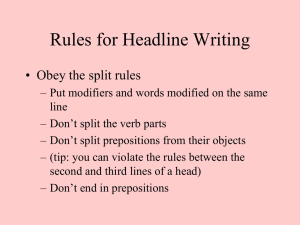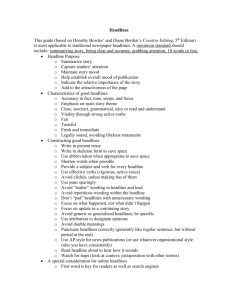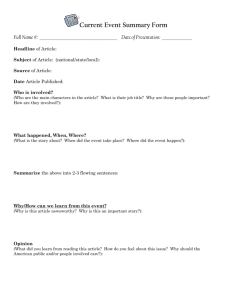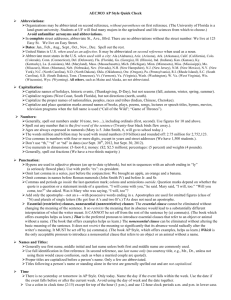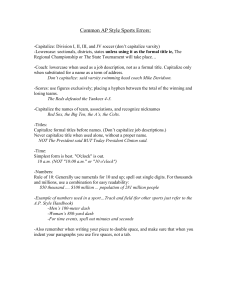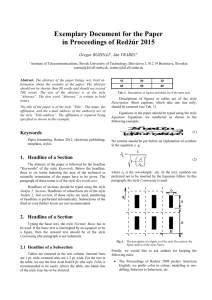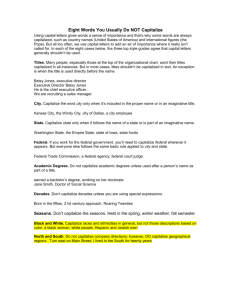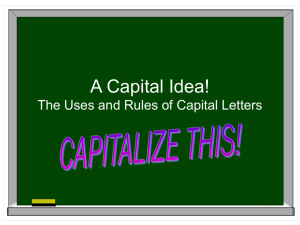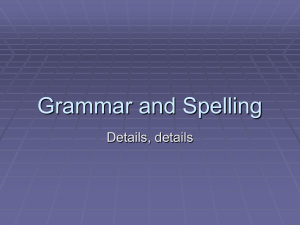Web content style guide
advertisement
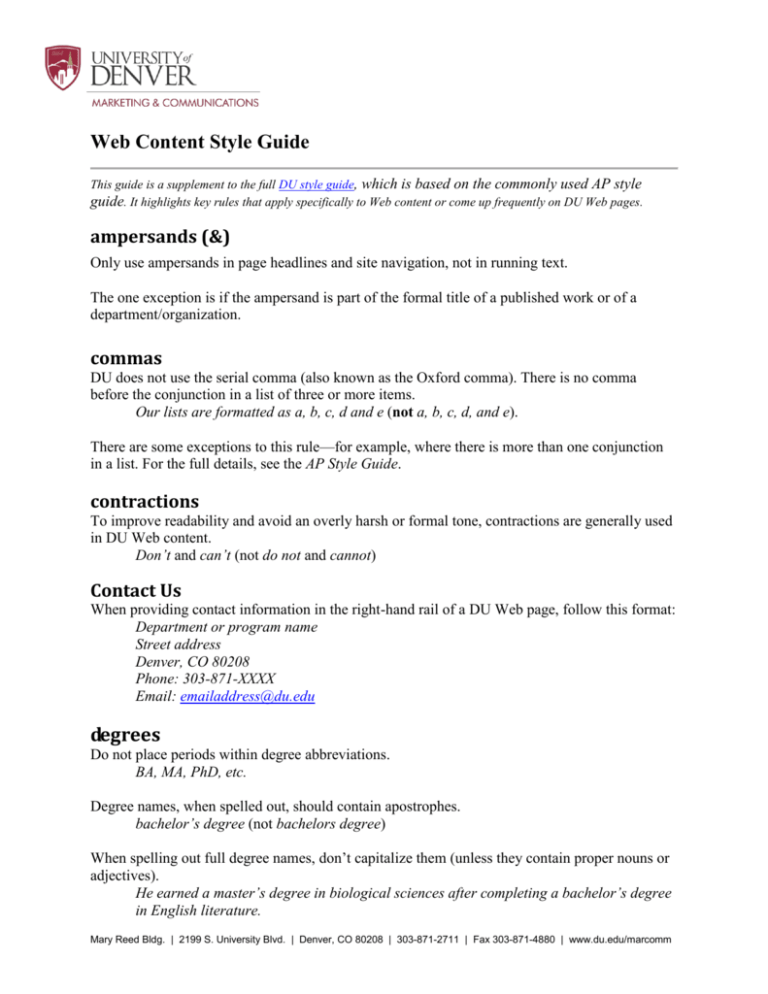
Web Content Style Guide This guide is a supplement to the full DU style guide, which is based on the commonly used AP style guide. It highlights key rules that apply specifically to Web content or come up frequently on DU Web pages. ampersands (&) Only use ampersands in page headlines and site navigation, not in running text. The one exception is if the ampersand is part of the formal title of a published work or of a department/organization. commas DU does not use the serial comma (also known as the Oxford comma). There is no comma before the conjunction in a list of three or more items. Our lists are formatted as a, b, c, d and e (not a, b, c, d, and e). There are some exceptions to this rule—for example, where there is more than one conjunction in a list. For the full details, see the AP Style Guide. contractions To improve readability and avoid an overly harsh or formal tone, contractions are generally used in DU Web content. Don’t and can’t (not do not and cannot) Contact Us When providing contact information in the right-hand rail of a DU Web page, follow this format: Department or program name Street address Denver, CO 80208 Phone: 303-871-XXXX Email: emailaddress@du.edu degrees Do not place periods within degree abbreviations. BA, MA, PhD, etc. Degree names, when spelled out, should contain apostrophes. bachelor’s degree (not bachelors degree) When spelling out full degree names, don’t capitalize them (unless they contain proper nouns or adjectives). He earned a master’s degree in biological sciences after completing a bachelor’s degree in English literature. Mary Reed Bldg. | 2199 S. University Blvd. | Denver, CO 80208 | 303-871-2711 | Fax 303-871-4880 | www.du.edu/marcomm Web content style guide 2 email/eEmail is one word with no hyphen and should only be capitalized if it begins a sentence. Other terms referring to electronic devices or businesses, however, should contain a lowercased “e,” followed by a hyphen and the product being described: email, e-commerce, e-reader, e-books Email addresses are written in all lowercase letters. file extensions If a link takes users to any type of file other than a web page (most commonly a PDF), indicate that in the linked text. You can either put “(PDF)” at the end of the link or, to link to a PDF version of text that already appears on an HTML page, use “Printer-friendly version.” job titles Don’t capitalize an individual’s job title unless it is their full formal title and it comes directly before their name. Joan Smith, chemistry professor Associate Professor of Chemistry Joan Smith or Assoc. Prof. Joan Smith Per AP style, don’t use the courtesy title “Dr.” before the name of an individual who holds a PhD. If it’s necessary to note their degree, set it off with commas after their name. headlines In Web pages built in the new DU template, there are two levels of headlines on each page. For sites in the up-to-date DU templates, these headlines are entered in the Properties section for each page. The system automatically displays the first level in a smaller font and all capital letters, and the second in a larger font, where you control which letters are capitalized. (You enter this in the Content Title Top field in OmniUpdate.) On most pages, the second headline is the name of the page. (This is the Content Title Bottom field in OmniUpdate.) You capitalize it as if it were the title of a book. The first headline is the name of the folder that the page is in. For example, if a site has a section called Academic Programs, and in that section there is a page called Internships and Interim Classes, the headlines would be: ACADEMIC PROGRAMS Internships and Interim Classes On the homepage of a site, however, because the header graphic already displays the name of the site, it doesn’t need to be repeated in the headline. So on the homepage, the second-level headline can be a statement that communicates one of your key messages. In this case, the Web content style guide 3 second headline is written as a complete sentence, and capitalized and punctuated as a sentence. UNIVERSITY COMMUNICATIONS We tell the DU story. links Hyperlinked text should usually be a noun that specifically describes the content of the page you’re linking to. The words “click here” should not be used for a link. For more information, see our course schedule. (not Click here to see our course schedule.) Generally, don’t spell out a URL in page text. Instead, make words into a link that leads to that URL. See our course schedule. (not To see our course schedule, visit http://www.du.edu/courseschedule.) When making text into a link, don’t include the spaces or punctuation before or after a word in the link. See our course schedule. (not See our course schedule. ) may and can Don’t use “may” to refer to something that someone is able to do. Sometimes writers avoid the word “can” because they feel it sounds overly informal, but in fact “can” is the grammatically correct way to indicate that something is physically possible. “May” indicates either that there is uncertainty that something may happen, or that someone is granted permission to do something. Students can file their documentation in the main office. (Not Students may file their documentation, which means either that there’s chance that students may file their documents, but also may not, or means that students are being granted permission to file their documents.) phone numbers Use hyphens in phone numbers, not periods or parentheses. 303-871-0000 (not 303.871.0000 or (303) 871-0000) spaces Use only one space—not two—between sentences. times, dates and places When providing event information, list it in the time, date, place (TDP) sequence. Place commas between the day of the week and the month. Also place commas between the date and anything that follows it. The concert is at 7 p.m. on Friday, April 22, 2011, at Magness Arena. Web content style guide 4 a.m./p.m.—Place periods between these designations. Always place a space between the number and “a.m.” or “p.m.” She played from 10 a.m.-2:30 p.m. Relative dates—Avoid describing dates in relative terms such as today, tomorrow, next quarter, next year or soon. Use absolute dates instead. April 13th or spring quarter 2012 (not next week or this spring) title tags The format for our title tags is Page Name | Site Name | University of Denver “ | University of Denver” is automatically appended at the end of each page’s title tag by the content management system, so all you will need to enter is Page Name | Site Name For more information about title tags and other metadata, see our Metadata Guide. “under construction” pages Placeholder pages containing nothing but text such as “Page under construction” or “Information to come” will not be published. We will wait to put these pages up until the content is available. University/university Capitalize “University” when referring specifically to DU in a second reference. When referring to a general university, don’t capitalize the word. DU has unique academic programs. The University offers hands-on learning opportunities. URL for DU websites When writing your DU website address in print materials or an advertisement, include the www. at the beginning of the address. www.du.edu/commencement, not du.edu/commencement Web Always capitalize the word “Web” when it stands alone. However, most terms that begin with the term “web” are combined as into one word, in all lowercase letters. Web; website; webcam; webcast; webmaster The term “Web page” is an exception. It’s written as two separate words. website Website is one word and lowercased (unless it’s the first word in a sentence).
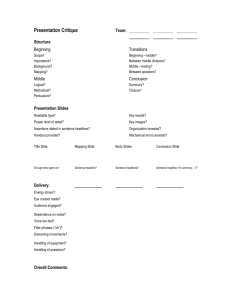
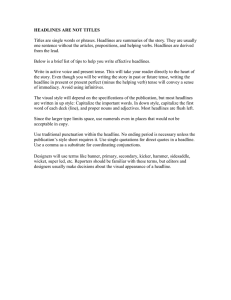
![[Type text] Fill in a fictional “headline from the future” above](http://s3.studylib.net/store/data/008674091_1-c12eeba0d4bd6938777e08ea064ad30a-300x300.png)
